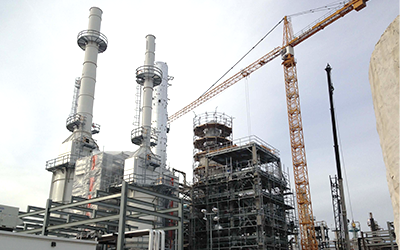Part 12
Part 12, focusing on forming and destabilizing emulsions, in the series on how the chemical industry is solving challenges in the industrial sector. Petroleum refining and oil and gas production operations generate both oil-in-water (O/W) and water-in-oil (W/O) emulsions. These emulsions are present in produced hydrocarbon fluids, drainage water, separator equipment, tank bottoms, and various oil recovery devises. In the petrochemical industry quench waters generated in ethylene and other olefin manufacturing operations may contain various hydrocarbons from heavy to light.
In the processing of crude oil, the crude oil is processed through desalting vessels designed to remove entrained salts. During this process forming and destabilizing emulsions becomes a factor.
The crude is mixed with water and the mixing generates water-in oil emulsions. While the equipment is designed for destabilizing emulsions, often the emulsion is not fully resolved and the residual emulsion must be further treated. Frequently these emulsions are dumped to an oily sewer along with various emulsions formed in the crude fractionator, thermal cracking, catalytic cracker, hydrocracker and other processes. These residual oil and water emulsion systems contain too much water to be placed back into the process so they are usually dumped into the oily water sewer system.
In the oily water sewer, the emulsions tend to be stabilized. All of these emulsion components mixed with oil spills, water run-off, oil run-off, oily waste water from various operations, storm water, dirt and any other debris are mixed through pumps and the flow turbulence form more emulsions.
Natural components of the crude oil such as asphaltenes, waxes, resins and naphthenic acids accumulate at the water-oil interface and hinder droplets of the dispersed phase liquid from coalescing and re-forming a separate phase. Asphaltenes, resins and waxes absorb at the water-in-crude oil interface to form a ridged film surrounding the water droplet, thereby protecting the interfacial film from rupturing during droplet collisions and preventing the formation of larger drops that would otherwise coalesce by gravity differential.
Emulsification, Stabilization and Separation
The formation of emulsions from two immiscible liquids phases – is probably the most versatile property of surface active agents for practical applications. Paints, polishes, pesticides, metal cuttings oils, margarine, milk, ice-cream, cosmetics and metal cleaners are all emulsions or are used in emulsified form.
An emulsion is defined as “significantly stable” suspension of particles of a liquid of a certain size within a second, immiscible liquid. The term “significantly stable” means relative to the intended use and may range from a few minutes to a few years. With respect to the size of the dispersed particles, two types of emulsions are recognized: macroemulsions and microemulsions. The usual type of emulsion (a macroemulsion) has a particle size range of 0.2 to 50 micrometers and is easily visible under the microscope.
The size of the dispersed particles in an emulsion determines its appearance to the naked eye. If the diameter of the dispersed particles is 1 micrometer, the emulsion is milky white; 0.1 – 1.0 micrometers, blue-white; 0.05 – 0.1 micrometers, gray, semitransparent; < 0.05 micrometers, transparent. Therefore, macroemulsions are opaque and microemulsions are either semitransparent or transparent.
Two immiscible, pure liquids cannot form an emulsion. For a suspension of one liquid in another to be stable enough to be classified as an emulsion, a third component must be present to stabilize the system. The third component is called an “emulsifying agent” and is usually a surfactant. The most effective emulsifying agents are usually mixtures of two or more substances.
Emulsions are of two types, based on the nature of the dispersed phase: oil-in-water (o/w) and water-in-oil (w/o). The oil-in-water type is a dispersion of a water-immiscible liquid (always called the “oil”) in an aqueous (water) phase. The oil, in this case, is the discontinuous (inner) phase; the aqueous phase is the continuous (outer) phase. The water-in-oil type is a dispersion of water or an aqueous solution in a water-immiscible liquid.
The type of emulsion formed by the water and oil depends on the nature of the emulsifying agent and on the process used in preparing the emulsion and the relative properties of the oil and water present. In general, o/w emulsions are produced by emulsifying agents that are more soluble in the water than in the oil phase, whereas, w/o emulsions are produced by emulsifying agents that are more soluble in the oil than in the water phase. One type of emulsion can be converted into the other type by changing the conditions – this is called inversion of the emulsion.
These two types of emulsions are easily distinguished:
- An emulsion can be readily diluted with more of the outer phase; not easily with the inner phase. O/W emulsions disperse readily in water; W/O do not, but they do disperse readily in “oil”.
- O/W emulsions conduct electricity; W/O emulsions do not.
- W/O emulsions will be colored by oil-soluble dyes, whereas O/W emulsions show the color faintly. O/W emulsions can be colored by water-soluble dyes.
- A drop of an O/W emulsion on filter paper produces an immediate wide moist area; a drop of W/O emulsion does not. If the filter paper is first saturated with a cobalt chloride solution and dried before the test, the area around the drop immediately turns “pink” if the emulsion is O/W and remains blue if it is W/O.
In the formation of an emulsion, one of the immiscible liquids is broken up into particles that are dispersed in the second liquid. Since the interfacial tension between two immiscible pure liquids is always greater than zero, the dispersion of the inner liquid produces a tremendous increase in the surface area of the interface between the liquids. This results in a large increase in the interfacial free energy of the system. The emulsion produced is thermodynamically highly unstable.
This is why two immiscible liquids, when pure, cannot form an emulsion and why emulsions of both types inherently separate upon standing.
Why does Forming and Destabilizing Emulsions Matter?
The function of the emulsifier (surfactant) is to stabilize this basically unstable system for sufficient time that it can perform some function. The emulsifier does a number of things:
- It reduces the interfacial tension between the two liquids.
- It decreases the rate of coalescence of the dispersed liquid particles by forming barriers around them electrically, mechanically and sterically. The steric and electrical barriers inhibit the close approach of one particle to another. The mechanical barrier increases the resistance of the dispersed particles to mechanical shock and prevents the particles from coalescing when they do collide.
The rate at which the droplets of an emulsion coalesce to form larger droplets, eventually resulting in destabilizing emulsions, depends on a number of factors:
- The physical nature of surfactants. Since the droplets of a dispersed liquid in an emulsion are in constant motion and there are frequent collisions between them, if the surfactant surrounding the two colliding droplets in an emulsion ruptures, the two droplets will merge to form a larger one. Therefore, the mechanical strength of the surfactant film is a prime factor.
- The existence of an electrical or steric barrier on the droplets. The presence of an electrical charge on the droplets provides an electrical repulsion effect preventing the droplets from merging.
- The viscosity of the continuous phase. An increase in the viscosity of the continuous phase reduces the diffusion coefficient of the droplets thereby reducing the frequency of collision of the droplets.
- The size distribution of the droplets. The size of the droplets directly effects the rate of coalescence of the droplets. The smaller the range of sizes the more stable the emulsion.
- Phase volume ratio. As the volume in the dispersed phase in an emulsion increases, the surfactant expands further to surround the droplets of the dispersed material and the basic instability of the system increases. As the volume of the dispersed phase increases beyond that of the external phase, the type of the emulsion (O/W or W/O) becomes more unstable relative to the other type.
- Temperature. A change in temperature causes changes in the interfacial tension between the two phases, in the viscosity of the surfactant film, in the relative solubility of the emulsifying agent in the two phases and in the thermal agitation of the dispersed particles. Temperature changes may invert the emulsion or cause it to break. Anything that disturbs the interface decreases the stability and a rise in the temperature causes an increased vapor pressure resulting in an increased flow of molecules through the interface with a decrease in stability.
The Process of Destabilizing Emulsions
Separation of the formed emulsion is primarily a process of coalescence. Aggregation of droplets occurs when they stay close to each other for a longer time than if there were no attractive forces acting between them. The mechanism of coalescence occurs in two stages: film drainage and film rupture. In order to have film drainage there must be a flow of liquid in the film and a pressure gradient present. However, if the interfacial film between the droplets has thinned to below some critical thickness, it ruptures, and the capillary pressure difference causes the droplets to rapidly fuse into one droplet. Therefore, the properties of the thin film are of the uttermost importance for the separation. If the droplets deform, the area of the interface increases and consequently the drainage path in the film also increases, resulting in lower drainage rates.
Stabilization by polymers or surfactants or adsorbed particles can create a mechanically strong and elastic interfacial film that can act as a barrier against aggregation and coalescence. Particles, such as dirt, clays, resins and asphaltenes which are oil-wet, tend to stabilize W/O emulsions while those that are water-wet tend to stabilize O/W emulsions. In order to stabilize the emulsion, the particles should be at least one order of magnitude smaller than the emulsion dispersed droplets and in sufficient concentration. Other factors that favor emulsion stability are low surface tension, high bulk phase viscosity and relatively small volumes of dispersed phase.
In the oil industry, the predominant emulsion type is the oil-in-water emulsion at the well site while the refinery slop streams produce primarily water-in-oil emulsions. Methods such as pH adjustment, filtration, membrane separation and heat treatment are often used for destabilizing emulsions.
Because of capital equipment cost, chemical treatment has become a very common method for destabilizing emulsions. Commercial demulsifiers are typical mixtures of several compounds. Each component of the demulsifier typically has a different partitioning ability and a different interfacial activity. In general, the chemical should have a strong attraction to the oil/water interface, with the ability to disrupt the protective film around the water droplet, the ability to work as a wetting agent, changing the contact angel of solids, promote film drainage and thinning of the interdroplet lamella. It has been shown in testing that chemical products that have equal partitioning between the aqueous and oil phases give the best results in destabilizing the emulsions.
Adsorption of the demulsifier molecule at the interface, high interfacial activity and reduced interfacial tension leads to a strong decrease in the rate of film thinning, and ultimately film rupturing and droplet coalescence. Because water droplets in oil tend to be positively charged, these types of emulsions are typically treated with an anionic (negative charge) organic breaker. Acidification may be effective in breaking the W/O emulsion if the acid dissolves some of the solid materials adsorbed at the interface and thus reduces the surface tension. The demulsifier molecule can then displace the original emulsifying agent from the interface.
One other consideration is the effect of the concentration of the treating chemicals on the emulsion stability as too much chemical can result in over-treating and actually stabilizing the emulsion. The chemicals to be injected should also be checked for chemical compatibility with other chemicals used in the system.



